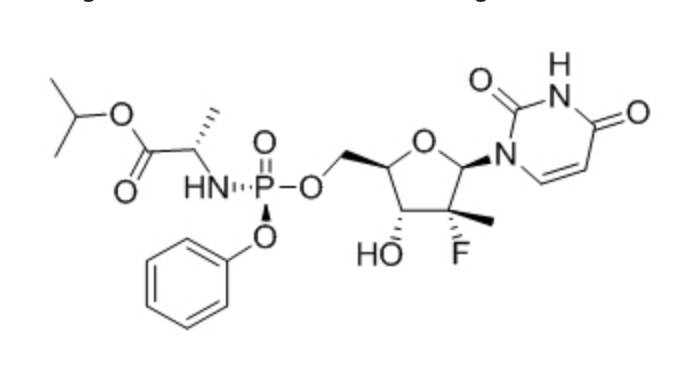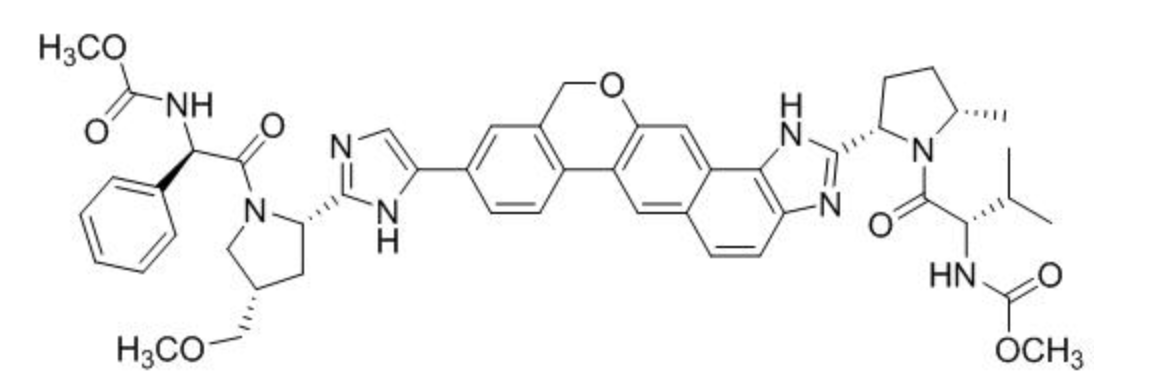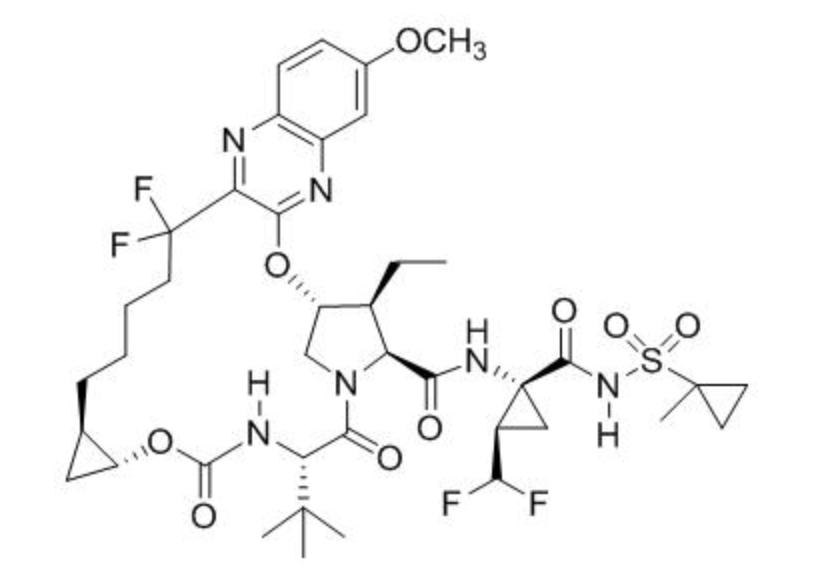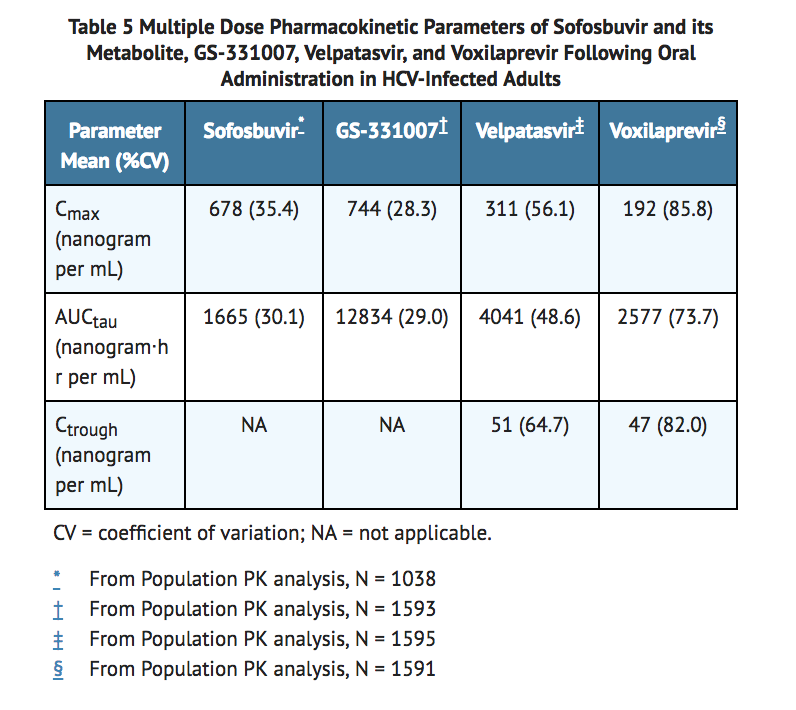Sofosbuvir / velpatasvir / voxilaprevir
Editor-In-Chief: C. Michael Gibson, M.S., M.D. [1]; Associate Editor(s)-in-Chief: Yashasvi Aryaputra[2];
Disclaimer
WikiDoc MAKES NO GUARANTEE OF VALIDITY. WikiDoc is not a professional health care provider, nor is it a suitable replacement for a licensed healthcare provider. WikiDoc is intended to be an educational tool, not a tool for any form of healthcare delivery. The educational content on WikiDoc drug pages is based upon the FDA package insert, National Library of Medicine content and practice guidelines / consensus statements. WikiDoc does not promote the administration of any medication or device that is not consistent with its labeling. Please read our full disclaimer here.
Black Box Warning
|
RISK OF HEPATITIS B VIRUS REACTIVATION IN PATIENTS COINFECTED WITH HCV AND HBV
See full prescribing information for complete Boxed Warning.
*Test all patients for evidence of current or prior hepatitis B virus (HBV) infection before initiating treatment with VOSEVI. HBV reactivation has been reported in HCV/HBV coinfected patients who were undergoing or had completed treatment with HCV direct-acting antivirals (DAA) and were not receiving HBV antiviral therapy. Some cases have resulted in fulminant hepatitis, hepatic failure, and death. Monitor HCV/HBV coinfected patients for hepatitis flare or HBV reactivation during HCV treatment and post-treatment follow-up. Initiate appropriate patient management for HBV infection as clinically indicated.
|
Overview
Sofosbuvir / velpatasvir / voxilaprevir is a Acetylcholine release inhibitor, Adrenergic receptor agonist that is FDA approved for the (type of indication of drug) of a list of indications, separated by commas.. There is a Black Box Warning for this drug as shown here. Common adverse reactions include a list of adverse reactions, separated by commas..
Adult Indications and Dosage
FDA-Labeled Indications and Dosage (Adult)
Condition 1
- Dosing Information
- (Dosage)
Condition 2
- Dosing Information
- (Dosage)
Off-Label Use and Dosage (Adult)
Guideline-Supported Use
Condition 1
- Developed by: (Organisation)
- Class of Recommendation: (Class) (Link)
- Strength of Evidence: (Category A/B/C) (Link)
- Dosing Information/Recommendation
- (Dosage)
Condition 2
- Developed by: (Organisation)
- Class of Recommendation: (Class) (Link)
- Strength of Evidence: (Category A/B/C) (Link)
- Dosing Information/Recommendation
- (Dosage)
Non–Guideline-Supported Use
Condition 1
- Dosing Information
- (Dosage)
Condition 2
- Dosing Information
- (Dosage)
Condition 3
- Dosing Information
- (Dosage)
Pediatric Indications and Dosage
FDA-Labeled Indications and Dosage (Pediatric)
Condition 1
- Dosing Information
- (Dosage)
Condition 2
- Dosing Information
- (Dosage)
Off-Label Use and Dosage (Pediatric)
Guideline-Supported Use
Condition 1
- Developed by: (Organisation)
- Class of Recommendation: (Class) (Link)
- Strength of Evidence: (Category A/B/C) (Link)
- Dosing Information/Recommendation
- (Dosage)
Condition 2
- Developed by: (Organisation)
- Class of Recommendation: (Class) (Link)
- Strength of Evidence: (Category A/B/C) (Link)
- Dosing Information/Recommendation
- (Dosage)
Non–Guideline-Supported Use
Condition 1
- Dosing Information
- (Dosage)
Condition 2
- Dosing Information
- (Dosage)
Condition 3
- Dosing Information
- (Dosage)
Contraindications
CONTRAINDICATIONS
Warnings
|
RISK OF HEPATITIS B VIRUS REACTIVATION IN PATIENTS COINFECTED WITH HCV AND HBV
See full prescribing information for complete Boxed Warning.
*Test all patients for evidence of current or prior hepatitis B virus (HBV) infection before initiating treatment with VOSEVI. HBV reactivation has been reported in HCV/HBV coinfected patients who were undergoing or had completed treatment with HCV direct-acting antivirals (DAA) and were not receiving HBV antiviral therapy. Some cases have resulted in fulminant hepatitis, hepatic failure, and death. Monitor HCV/HBV coinfected patients for hepatitis flare or HBV reactivation during HCV treatment and post-treatment follow-up. Initiate appropriate patient management for HBV infection as clinically indicated.
|
Conidition 1
(Description)
Conidition 2
(Description)
Conidition 3
(Description)
Adverse Reactions
Clinical Trials Experience
Central Nervous System
- (list/description of adverse reactions)
Cardiovascular
- (list/description of adverse reactions)
Respiratory
- (list/description of adverse reactions)
Gastrointestinal
- (list/description of adverse reactions)
Hypersensitive Reactions
- (list/description of adverse reactions)
Miscellaneous
- (list/description of adverse reactions)
Condition 2
Central Nervous System
- (list/description of adverse reactions)
Cardiovascular
- (list/description of adverse reactions)
Respiratory
- (list/description of adverse reactions)
Gastrointestinal
- (list/description of adverse reactions)
Hypersensitive Reactions
- (list/description of adverse reactions)
Miscellaneous
- (list/description of adverse reactions)
Postmarketing Experience
(Description)
Drug Interactions
- Drug 1
- Drug 2
- Drug 3
- Drug 4
- Drug 5
Drug 1
(Description)
Drug 2
(Description)
Drug 3
(Description)
Drug 4
(Description)
Drug 5
(Description)
Use in Specific Populations
Pregnancy
Pregnancy Category (FDA):
(Description)
Pregnancy Category (AUS):
There is no Australian Drug Evaluation Committee (ADEC) guidance on usage of Sofosbuvir / velpatasvir / voxilaprevir in women who are pregnant.
Labor and Delivery
(Description)
Nursing Mothers
(Description)g
Pediatric Use
(Description)
Geriatic Use
(Description)
Gender
(Description)
Race
(Description)
Renal Impairment
(Description)
Hepatic Impairment
(Description)
Females of Reproductive Potential and Males
(Description)
Immunocompromised Patients
(Description)
Others
(Description)
Administration and Monitoring
Administration
Oral
- Administer with food.
Monitoring
- Hepatitis C virus genotype: Prior to initiation of therapy.
- Reduction in HCV-RNA viral load and improvement in signs/symptoms of chronic hepatitis C genotype 1 infection may indicate efficacy.
- Hepatitis B virus (HBV) current or prior infection: Prior to initiation.
- Clinical and laboratory signs of hepatitis flare or HBV reactivation, in patients with evidence of current or prior HBV infection: During treatment and post-treatment follow-up.
- Cardiac monitoring in in-patient setting: First 48 hours during concomitant therapy with amiodarone or if discontinuing amiodarone just prior to treatment initiation.
IV Compatibility
There is limited information regarding the compatibility of Sofosbuvir / velpatasvir / voxilaprevir and IV administrations.
Overdosage
- No specific antidote is available for overdose with VOSEVI. If overdose occurs the patient must be monitored for evidence of toxicity. Treatment of overdose with VOSEVI consists of general supportive measures including monitoring of vital signs as well as observation of the clinical status of the patient. Hemodialysis can efficiently remove the predominant circulating metabolite of sofosbuvir, GS-331007, with an extraction ratio of 53%. Hemodialysis is unlikely to result in significant removal of velpatasvir or voxilaprevir since velpatasvir and voxilaprevir are highly bound to plasma protein.
Pharmacology
Mechanism of Action
- VOSEVI is a fixed-dose combination of sofosbuvir, velpatasvir, and voxilaprevir which are DAA agents against the hepatitis C virus.
Structure



Pharmacodynamics
Cardiac Electrophysiology
- The effect of sofosbuvir 400 mg (recommended dosage) and 1200 mg (3 times the recommended dosage) on QTc interval was evaluated in an active-controlled (moxifloxacin 400 mg) thorough QT trial. At a dose 3 times the recommended dose, sofosbuvir does not prolong QTc to any clinically relevant extent.
- The effect of velpatasvir 500 mg (5 times the recommended dosage) was evaluated in an active-controlled (moxifloxacin 400 mg) thorough QT trial. At a dose 5 times the recommended dose, velpatasvir does not prolong QTc interval to any clinically relevant extent.
- The effect of voxilaprevir 900 mg (9 times the recommended dosage) was evaluated in an active-controlled (moxifloxacin 400 mg) thorough QT trial. At a dose 9 times the recommended dose, voxilaprevir does not prolong QTc interval to any clinically relevant extent.
Pharmacokinetics
- The pharmacokinetic properties of the components of VOSEVI are provided in Table 4. The multiple dose pharmacokinetic parameters of sofosbuvir and its metabolite GS-331007, velpatasvir, and voxilaprevir are provided in Table 5.


- Sofosbuvir and GS-331007 AUC0–24 and Cmax were similar in healthy adult subjects and subjects with HCV infection. Relative to healthy subjects (N=137), velpatasvir AUC0–24 and Cmax were 41% lower and 39% lower, respectively, in HCV-infected subjects. Relative to healthy subjects (N=63), voxilaprevir AUC0–24 and Cmax were both 260% higher in HCV-infected subjects.
- Sofosbuvir and GS-331007 AUCs are near dose-proportional over the dose range of 200 mg to 1200 mg. Velpatasvir AUC increases in a greater than proportional manner from 5 to 50 mg and in a less than proportional manner from 50 to 450 mg in healthy volunteers. However, velpatasvir exhibited near dose-proportional increase in exposures 25 mg to 150 mg in HCV-infected patients. Voxilaprevir AUC increases in a greater than proportional manner over the dose range of 100 to 900 mg when administered with food.
Specific Populations
- Pediatric Patients: The pharmacokinetics of VOSEVI in pediatric patients has not been established.
- Geriatric Patients: Population pharmacokinetic analysis in HCV-infected subjects showed that within the age range (18 to 85 years) analyzed, age did not have a clinically relevant effect on the exposure to sofosbuvir, GS-331007, velpatasvir, or voxilaprevir.
Patients with Renal Impairment:
- The pharmacokinetics of sofosbuvir were studied in HCV-negative subjects with mild (eGFR between 50 to less than 80 mL/min/1.73 m2), moderate (eGFR between 30 to less than 50 mL/min/1.73 m2), severe renal impairment (eGFR less than 30 mL/min/1.73 m2), and subjects with ESRD requiring hemodialysis following a single 400 mg dose of sofosbuvir. Relative to subjects with normal renal function (eGFR greater than 80 mL/min/1.73 m2), the sofosbuvir AUC0–inf was 61%, 107%, and 171% higher in subjects with mild, moderate, and severe renal impairment, while the GS-331007 AUC0–inf was 55%, 88%, and 451% higher, respectively. In subjects with ESRD, relative to subjects with normal renal function, sofosbuvir and GS-331007 AUC0–inf was 28% and 1280% higher when sofosbuvir was dosed 1 hour before hemodialysis compared with 60% and 2070% higher when sofosbuvir was dosed 1 hour after hemodialysis, respectively. A 4-hour hemodialysis session removed approximately 18% of administered dose of sofosbuvir.
- The pharmacokinetics of velpatasvir were studied with a single dose of 100 mg velpatasvir in HCV-negative subjects with severe renal impairment (eGFR less than 30 mL/min by Cockcroft-Gault). No clinically relevant differences in velpatasvir pharmacokinetics were observed between healthy subjects and subjects with severe renal impairment.
- The pharmacokinetics of voxilaprevir were studied with a single dose of 100 mg voxilaprevir in HCV-negative subjects with severe renal impairment (eGFR < 30 mL/min by Cockcroft-Gault). No clinically relevant differences in voxilaprevir pharmacokinetics were observed between healthy subjects and subjects with severe renal impairment.
Patients with Hepatic Impairment:
- The pharmacokinetics of sofosbuvir were studied following 7-day dosing of 400 mg sofosbuvir in HCV-infected subjects with moderate and severe hepatic impairment (Child-Pugh B and C). Relative to subjects with normal hepatic function, the sofosbuvir AUC0–24 was 126% and 143% higher in subjects with moderate and severe hepatic impairment, respectively, while the GS-331007 AUC0–24 was 18% and 9% higher, respectively. Population pharmacokinetic analysis in HCV-infected subjects indicated that compensated cirrhosis (Child-Pugh A) had no clinically relevant effect on the exposure of sofosbuvir and GS-331007.
- The pharmacokinetics of velpatasvir were studied with a single dose of 100 mg velpatasvir in HCV-negative subjects with moderate and severe hepatic impairment (Child-Pugh B and C). Velpatasvir plasma exposure (AUCinf) was similar in subjects with moderate hepatic impairment, severe hepatic impairment, and control subjects with normal hepatic function. Population pharmacokinetic analysis in HCV-infected subjects indicated that compensated cirrhosis (Child-Pugh A) had no clinically relevant effect on the exposure of velpatasvir.
- The pharmacokinetics of voxilaprevir were studied with a single dose of 100 mg voxilaprevir in HCV-negative subjects with moderate and severe hepatic impairment (Child-Pugh B and C). Relative to subjects with normal hepatic function, the voxilaprevir AUCinf was 299% and 500% higher in subjects with moderate and severe hepatic impairment, respectively. Population pharmacokinetic analysis in HCV-infected subjects indicated that subjects with compensated cirrhosis (Child-Pugh A) had 73% higher exposure of voxilaprevir than those without cirrhosis.
- Race and Gender: Population pharmacokinetics analysis in HCV-infected subjects indicated that race and gender had no clinically relevant effect on the exposure of sofosbuvir, GS-331007, velpatasvir, or voxilaprevir.
Drug Interaction Studies
- After oral administration of VOSEVI, sofosbuvir is rapidly absorbed and subject to extensive first-pass hepatic extraction (hydrolysis followed by sequential phosphorylation) to form the pharmacologically active triphosphate. In clinical pharmacology studies, both sofosbuvir and the primary circulating metabolite GS-331007 (dephosphorylated nucleotide metabolite) were monitored for purposes of pharmacokinetic analyses.
- Sofosbuvir, velpatasvir, and voxilaprevir are substrates of drug transporters P-gp and BCRP while GS-331007 is not. Voxilaprevir, and to a lesser extent velpatasvir, are also substrates of OATP1B1 and OATP1B3. In vitro, slow metabolic turnover of velpatasvir by CYP2B6, CYP2C8, and CYP3A4 and of voxilaprevir by CYP1A2, CYP2C8, and primarily CYP3A4 was observed. Inducers of P-gp and/or moderate to potent inducers of CYP2B6, CYP2C8, or CYP3A4 (e.g., St. John's wort, carbamazepine) may significantly decrease plasma concentrations of sofosbuvir, velpatasvir, and/or voxilaprevir leading to reduced therapeutic effect of VOSEVI. Coadministration with drugs that inhibit P-gp and/or BCRP may increase sofosbuvir, velpatasvir, and/or voxilaprevir plasma concentrations without increasing GS-331007 plasma concentration. Coadministration with drugs that inhibit OATP may increase voxilaprevir plasma concentrations. Drugs that inhibit CYP2B6, CYP2C8, or CYP3A4 may increase plasma concentration of velpatasvir and/or voxilaprevir.
- Sofosbuvir and GS-331007 are not inhibitors of drug transporters P-gp, BCRP, OATP1B1, OATP1B3, or OCT1 and GS-331007 is not an inhibitor of OAT1, OAT3, OCT2, or MATE1. Sofosbuvir and GS-331007 are not inhibitors or inducers of CYP or UGT1A1 enzymes.
- Velpatasvir is an inhibitor of drug transporters P-gp, BCRP, OATP1B1, OATP1B3, and OATP2B1, and its involvement in drug interactions with these transporters is primarily limited to the process of absorption. At clinically relevant concentrations, velpatasvir is not an inhibitor of hepatic transporters OATP1A2 or OCT1, renal transporters OCT2, OAT1, OAT3 or MATE1, or CYP or UGT1A1 enzymes.
- Voxilaprevir is an inhibitor of drug transporters P-gp, BCRP, OATP1B1 and OATP1B3, and its involvement in drug interactions with these transporters is primarily limited to the process of absorption. At clinically relevant concentrations, voxilaprevir is not an inhibitor of hepatic transporters OCT1, renal transporters OCT2, OAT1, OAT3 or MATE1, or CYP or UGT1A1 enzymes.
- The effects of coadministered drugs on the exposure of sofosbuvir, GS-331007, velpatasvir, and voxilaprevir are shown in Table 6. The effects of sofosbuvir, velpatasvir, voxilaprevir, sofosbuvir/velpatasvir, or VOSEVI on the exposure of coadministered drugs are shown in Table 7.
- No effect on the pharmacokinetic parameters of sofosbuvir, GS-331007, velpatasvir, or voxilaprevir was observed with the combination of emtricitabine, rilpivirine, and tenofovir alafenamide; famotidine; gemfibrozil; or the combination of raltegravir, emtricitabine, and tenofovir DF.
- No effect on the pharmacokinetic parameters of the following coadministered drugs was observed with VOSEVI (ethinyl estradiol/norgestimate) or its components sofosbuvir/velpatasvir (dolutegravir) or sofosbuvir (methadone).
Nonclinical Toxicology
Carcinogenesis, Mutagenesis, Impairment of Fertility
Carcinogenesis and Mutagenesis
- Sofosbuvir: Sofosbuvir was not genotoxic in a battery of in vitro or in vivo assays, including bacterial mutagenicity, chromosome aberration using human peripheral blood lymphocytes and in vivo mouse micronucleus assays.
- Sofosbuvir was not carcinogenic in a 2-year mouse study (up to 200 mg/kg/day in males and 600 mg/kg/day in females) and in a 2-year rat study (up to 750 mg/kg/day), resulting in exposures of the predominant circulating metabolite GS-331007 of approximately 4 and 17 times (in male and female mice, respectively) and 9 times (in rats) the exposure in humans at the recommended human dose (RHD).
- Velpatasvir: Velpatasvir was not genotoxic in a battery of in vitro or in vivo assays, including bacterial mutagenicity, chromosome aberration using human peripheral blood lymphocytes, and in vivo rat micronucleus assays.
- Velpatasvir was not carcinogenic in a 26-week transgenic mouse study (up to 1000 mg/kg/day). A carcinogenicity study in rats is ongoing.
- Voxilaprevir: Voxilaprevir was not genotoxic in a battery of in vitro or in vivo assays, including bacterial mutagenicity, chromosome aberration using human peripheral blood lymphocytes and in vivo rat micronucleus assays.
- Carcinogenicity studies for voxilaprevir have not been conducted.
Impairment of Fertility
- Sofosbuvir: Sofosbuvir had no effects on embryo-fetal viability or on fertility when evaluated in rats. At the highest dose tested, AUC exposure to the predominant circulating metabolite GS-331007 was approximately 4 times the exposure in humans at the RHD.
- Velpatasvir: Velpatasvir had no effects on embryo-fetal viability or on fertility when evaluated in rats. At the highest dose tested, velpatasvir exposure was approximately 4 times the exposure in humans at the RHD.
- Voxilaprevir: Voxilaprevir had no effects on embryo-fetal viability or on fertility when evaluated in rats. At the highest dose tested, voxilaprevir exposure was approximately 149 times the exposure in humans at the RHD.
Clinical Studies
Description of Clinical Trials
- The efficacy of VOSEVI was evaluated in two Phase 3 trials in DAA-experienced subjects with genotype 1, 2, 3, 4, 5, or 6 HCV infection without cirrhosis or with compensated cirrhosis, as summarized in Table 8.

- Serum HCV RNA values were measured during the clinical trials using the COBAS AmpliPrep/COBAS Taqman HCV test (version 2.0) with a lower limit of quantification (LLOQ) of 15 IU/mL. Sustained virologic response (SVR12), defined as HCV RNA less than LLOQ at 12 weeks after the cessation of treatment, was the primary endpoint in both trials. Relapse is defined as HCV RNA greater than or equal to LLOQ after end-of-treatment response among subjects who completed treatment. On-treatment virologic failure is defined as breakthrough, rebound, or non-response.
Clinical Trials in HCV DAA-Experienced Subjects
NS5A Inhibitor-Experienced Adults Without Cirrhosis or With Compensated Cirrhosis (POLARIS-1)
- POLARIS-1 was a randomized, double-blind, placebo-controlled trial that evaluated 12 weeks of treatment with VOSEVI compared with 12 weeks of placebo in DAA-experienced subjects with genotype 1, 2, 3, 4, 5, or 6 HCV infection without cirrhosis or with compensated cirrhosis who previously failed a regimen containing an NS5A inhibitor. Subjects with genotype 1 HCV infection were randomized 1:1 to each group. Subjects with genotype 2, 3, 4, 5, or 6 HCV infection were enrolled to the VOSEVI group. Randomization was stratified by the presence or absence of cirrhosis.
- Demographics and baseline characteristics were generally balanced across treatment groups. Of the 415 treated subjects, the median age was 59 years (range: 27 to 84); 77% of the subjects were male; 81% were White; 14% were Black; 6% were Hispanic or Latino; 33% had a baseline body mass index at least 30 kg/m2; the majority of subjects had genotype 1 (72%) or genotype 3 (19%) HCV infection; 82% had a non-CC IL28B genotype (CT or TT); 74% had baseline HCV RNA levels at least 800,000 IU/mL; and 41% had compensated cirrhosis. In the POLARIS-1 trial, prior DAA regimens contained the following NS5A inhibitors: ledipasvir (51%), daclatasvir (27%), ombitasvir (11%), velpatasvir (7%), and elbasvir (3%).
- Table 9 presents the SVR12 by HCV genotype for the POLARIS-1 trial. No subjects in the placebo group achieved SVR12.
DAA-Experienced Adults Without Cirrhosis or With Compensated Cirrhosis Who Had Not Received An NS5A Inhibitor (POLARIS-4)
- POLARIS-4 was a randomized, open-label trial that evaluated 12 weeks of treatment with VOSEVI and 12 weeks of treatment with SOF/VEL in subjects with genotype 1, 2, 3, or 4 HCV infection without cirrhosis or with compensated cirrhosis who had previously failed a HCV DAA-containing regimen that did not include an NS5A inhibitor. Subjects whose only DAA exposure was an NS3/4A protease inhibitor were excluded. Subjects with genotype 1, 2, or 3 HCV infection were randomized 1:1 to each group. Randomization was stratified by HCV genotype and by the presence or absence of cirrhosis. Subjects with genotype 4 HCV infection were enrolled to the VOSEVI group. No subjects with genotype 5 or 6 were enrolled.
- Demographics and baseline characteristics were generally balanced across treatment groups. Of the 333 treated subjects, the median age was 58 years (range: 24 to 85); 77% of the subjects were male; 87% were White, 9% were Black; 8% were Hispanic or Latino; 35% had a baseline body mass index at least 30 kg/m2; 81% had non-CC IL28B genotypes (CT or TT); 75% had baseline HCV RNA levels at least 800,000 IU/mL; and 46% had compensated cirrhosis. In the POLARIS-4 trial, prior DAA regimens contained sofosbuvir (85%) with the following: peginterferon alfa and ribavirin or ribavirin (69%), HCV NS3/4A protease inhibitor (boceprevir, simeprevir, or telaprevir; 15%) and investigational DAA (<1%). Of the 15% of subjects without prior sofosbuvir exposure, most received investigational HCV DAAs or approved HCV NS3/4A protease inhibitors, with or without peginterferon alfa and ribavirin.
- Treatment with VOSEVI for 12 weeks resulted in numerically higher SVR12 rates than treatment with sofosbuvir/velpatasvir for 12 weeks in subjects with HCV genotype 1a and 3 infection. Comparable SVR12 rates were observed in subjects with HCV genotype 1b and 2 infection treated with VOSEVI for 12 weeks or with sofosbuvir/velpatasvir for 12 weeks. No comparison data are available for HCV genotypes 4, 5, and 6. Given these data, the additional benefit of VOSEVI has not been shown over sofosbuvir/velpatasvir for these genotypes and VOSEVI is only indicated for the treatment of HCV genotypes 1a or 3 infection in adults who previously received sofosbuvir without an NS5A inhibitor.
- Table 10 presents the comparative virologic outcome data for HCV genotype 1, 2, and 3 subjects with prior exposure to a sofosbuvir-containing regimen.

- In POLARIS-4, VOSEVI was administered for 12 weeks to 18 HCV genotype 4 subjects (with or without cirrhosis) who had prior exposure to a SOF-containing regimen without an NS5A inhibitor. All subjects achieved SVR12.
How Supplied
- Each VOSEVI tablet contains 400 mg of sofosbuvir, 100 mg of velpatasvir, and 100 mg of voxilaprevir. The tablets are beige, capsule-shaped, film-coated, and debossed with "GSI" on one side and "Figure" on the other side. Each bottle contains 28 tablets (NDC 61958-2401-1), polyester coil, silica gel desiccant, and is closed with a child-resistant closure.
Storage
- Store below 30 °C (86 °F). Dispense only in original container.
Images
Drug Images
{{#ask: Page Name::Sofosbuvir / velpatasvir / voxilaprevir |?Pill Name |?Drug Name |?Pill Ingred |?Pill Imprint |?Pill Dosage |?Pill Color |?Pill Shape |?Pill Size (mm) |?Pill Scoring |?NDC |?Drug Author |format=template |template=DrugPageImages |mainlabel=- |sort=Pill Name }}
Package and Label Display Panel

{{#ask: Label Page::Sofosbuvir / velpatasvir / voxilaprevir |?Label Name |format=template |template=DrugLabelImages |mainlabel=- |sort=Label Page }}
Patient Counseling Information
Risk of Hepatitis B Virus Reactivation in Patients Coinfected with HCV and HBV
- Inform patients that HBV reactivation can occur in patients coinfected with HBV during or after treatment of HCV virus infection. Advise patients to tell their healthcare provider if they have a history of hepatitis B infection.
Serious Symptomatic Bradycardia When Coadministered with Amiodarone
- Advise patients to seek medical evaluation immediately for symptoms of bradycardia such as near-fainting or fainting, dizziness or lightheadedness, malaise, weakness, excessive tiredness, shortness of breath, chest pain, confusion or memory problems.
Drug Interactions
- Inform patients that VOSEVI may interact with other drugs. Advise patients to report to their healthcare provider the use of any other prescription or nonprescription medication or herbal products including St. John's wort.
Administration
- Advise patients to take VOSEVI once daily on a regular dosing schedule with food. Inform patients that it is important not to miss or skip doses and to take VOSEVI for the duration that is recommended by the physician.

Precautions with Alcohol
Alcohol-Sofosbuvir / velpatasvir / voxilaprevir interaction has not been established. Talk to your doctor regarding the effects of taking alcohol with this medication.
Brand Names
- Vosevi
Look-Alike Drug Names
There is limited information regarding Sofosbuvir / velpatasvir / voxilaprevir Look-Alike Drug Names in the drug label.
Drug Shortage Status
Drug Shortage
Price
References
The contents of this FDA label are provided by the National Library of Medicine.
- ↑
- ↑ "Epclusa (sofosbuvir and velpatasvir) Tablets, for Oral Use. Full Prescribing Information" (PDF). Gilead Sciences, Inc. Foster City, CA 94404. Retrieved 1 August 2016.
- ↑ "voxilaprevir_msds".